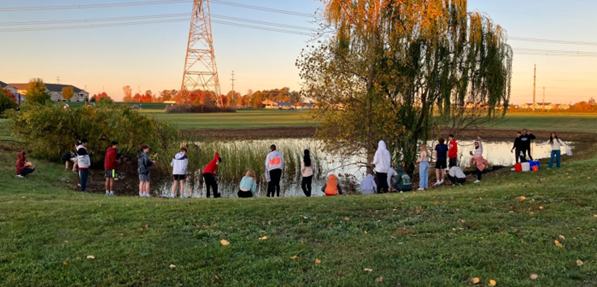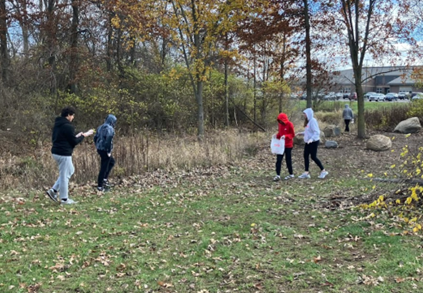Defining a Followship

Fund for Teachers awards grants to individuals and teams of teachers, and one of the most common questions we get is, “What constitutes a team?” The easy answer is “two or more teachers.” For the team from Central Ohio, the answer was “one fifth-grade teacher, a special education teacher, two sixth-grade science teachers, and four eighth-grade science teachers from six schools and two school districts.”
Recently team lead Josh Flory shared an update on the team’s “followship,” a term we coined to describe the student impact of our fellowships. His communique made our day and underscores why Fund for Teachers plays a vital role in teacher retention and student engagement:
“In 2022 you funded a team proposal that allowed seven colleagues and me to travel to Olympic National Park in Washington State to participate in a week-long educator workshop focused on using the outdoors as an instructional tool. The purpose of our proposal was to:
- reconnect our students to each other after Covid
- connect them with the natural world around them as a way to enrich their learning experience and improve their mental and physical health, and
- engage them in authentic learning experiences.

After our fellowship, I had the opportunity to transfer schools within my district to be in the same building as another team member. This has allowed us to collaborate and move forward with our initiatives much more efficiently. Specifically, we have almost completed the first phase of our new outdoor classroom and conservation corridor.


During our time in the national park, we had the opportunity to do science fieldwork. We wanted to bring this experience back to our students, so we started looking at our school site in hopes of creating a natural outdoor learning space. We are located in Delaware County, one of the fastest growing counties in the nation. Farmland is rapidly being converted into neighborhoods; however, we are fortunate to have several acres of land surrounding our school. We realized we have natural features that could be the basis of a restored natural ecosystem. I rewrote my biology unit to focus on the possibility of restoring the biodiversity that was once present on the property where my school sits today. The image below shows our school building in the bottom right corner. The stream and pond became focal points of our efforts to create an outdoor learning space.

Last year, my eighth-grade students worked to create a comprehensive site plan for this area. They conducted a BioBlitz where they catalogued all of the plants growing in this area, determined which ones were invasive, and then proposed native species to replace them. This year’s students, shown below, started implementing this planting plan. We secured a donation of 500 native wetland plants from a local nursery, and my students eagerly planted them at the edge of the pond. For many of them, this was the first time planting a plant. They are already looking forward to spring to see how their plants survive the winter.

My students have also made progress on our first outdoor classroom space, partially shown below. We obtained several large glacial erratics (boulders) to serve as teaching tools and a seating area. These rocks were moved to this area by glaciers, so they help us teach students about the history of this place. We have also obtained limestone boulders from a nearby quarry to help students see how Ohio used to be under a warm shallow ocean. This spring they will be able to find fossils in those rocks showing them firsthand evidence of the changes our area has experienced.

In December, my students started working on our second outdoor classroom space (shown below). A small woodland on our property protects a vernal that provides a home for salamanders and frogs in the spring. Most of my students have never seen how these creatures use these temporary pools to reproduce each spring.

My students are proud of the work they have completed thus far. I am most pleased with the changes I have seen in my them. At the end of the school year, I have them complete a reflection assignment to think about their growth as a learner and also to give me feedback and suggestions for my class. Here are just a few of their comments:
- “I liked how comfortable our class was with each other. We felt like we could share without being judged.”
- “Thank you for believing in us and helping us do real work. I feel like I can make a difference in the world.”
- “I loved the questions that we explored, and how we tried to find solutions for the biodiversity problem we face. I feel like I can impact the world.”
Beyond my classroom, my FFT travel group members continue to encourage each other, share resources, and work toward our common goals. Collectively, your support has likely reached 1,500 students in Central Ohio in some way. The experience in Olympic National Park has also connected me with a national cohort of teachers who are passionate about connecting our students with our public lands. Our group is working with our national parks and forests to see how we can support those organizations’ efforts to create the next generation of public land stewards.
In summary – thank you. Thank you for believing in and trusting teachers. When given the resources, teachers can do great things with and for their students. I am excited for what lies ahead.”
Thank YOU, Josh. We’re proud to call you an FFT Fellow.
Download this lesson Josh created based on their fellowship.

 Back to Blogs
Back to Blogs